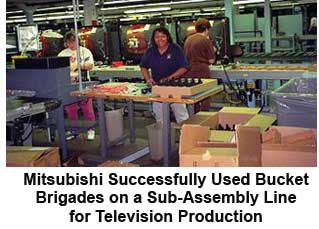Bucket Brigades versus the Toyota Sewing System
Some observers have compared the Bucket Brigade concept with the Toyota Sewing System (TSS), and there are similarities. But TSS traditionally involves static zones, and doesn’t incorporate the idea of sequencing workers from slowest to speediest, as Bucket Brigades do. These changes accelerate each product through the assembly line, and give Bucket Brigades their self-organizing attributes.
As Bartholdi has written: “A classic challenge in the management of assembly lines is to balance the assignment of work so that there are no bottlenecks in the flow. This is hard to do because it requires, first, knowing how much work is inherent in assembly; and then dividing that work appropriately among the workers. Balancing an assembly line is typically done by engineers and represents a significant project.”
He adds, “Because Bucket Brigades are self-organizing, the need for such centralized engineering is reduced or even eliminated. Furthermore, Bucket Brigades are able to achieve better balance than any engineering team because Bucket Brigades redistribute the work based, not on estimates (time-motion studies), but on the time it actually took a particular worker to perform a particular task.”
In a 2004 research paper, Bartholdi and Eisenstein showed how Bucket Brigades could be used in a network of subassembly lines (“in-tree assembly”). Traditionally, line balance is difficult to achieve in such a manufacturing scenario, as it requires that all subassembly lines be synchronized to produce at the same rate.
 The research showed that by employing a ‘‘Bucket Brigade’’ approach to work-sharing, line balancing can emerge spontaneously. While noting some practical and management challenges that may be greater than those faced in order picking situations, nonetheless they conclude that “In practice it may be quite easy to implement Bucket Brigades on in-tree assembly systems because real assembly trees are fairly simple, at least in our experience.” The research showed that by employing a ‘‘Bucket Brigade’’ approach to work-sharing, line balancing can emerge spontaneously. While noting some practical and management challenges that may be greater than those faced in order picking situations, nonetheless they conclude that “In practice it may be quite easy to implement Bucket Brigades on in-tree assembly systems because real assembly trees are fairly simple, at least in our experience.”
An interesting research project by students at the University of Canterbury in New Zealand found that productivity at one manufacturing company, throughput could be improved by 15% with fewer workers through the adoption of the Bucket Brigade concept.
Success at
Mitsubishi Consumer Electronics America
A few years ago, Bartholi and some colleagues presented the concept to
Mitsubishi Consumer Electronics America. The plant was having trouble balancing the work of several sub-assembly lines for television components. The concept was introduced to a single three-person team, to start, simply over a lunch break.
Bartholdi has written that "While we watched, subassembly work-in-process inventory shrank away until the portable conveyor the company was using was empty and no longer needed. The line manager had it removed, which cleared up about 150 square feet of prime real-estate. During the next two hours, the feeder line reduced the queue of waiting TV's until it was clear that the feeder line was no longer a bottleneck."
The approach was so successful, it was subsequently applied to other sub-assembly and packaging lines, with similar results.
Bartholdi himself says Bucket Brigades in manufacturing are most applicable
when an operation uses mostly one-dimensional work tasks (e.g., simple assembly that calls for no special skills beyond eye-hand coordination and motivation); work that is easily interruptible so that it can be handed-off to a colleague; and work stations that are relatively close together so that there is not too much walking involved.
While Bucket Brigades are not appropriate for many manufacturing environments, it is also safe to say the concept probably can be successfully applied to improve throughput or reduce costs in hundreds or thousands of manufacturing centers.
Have you looked at or considered Bucket Brigades in Manufacturing? Where does the concept make the most sense? What are the issues? Let us know your thoughts at the Feedback button below.
|